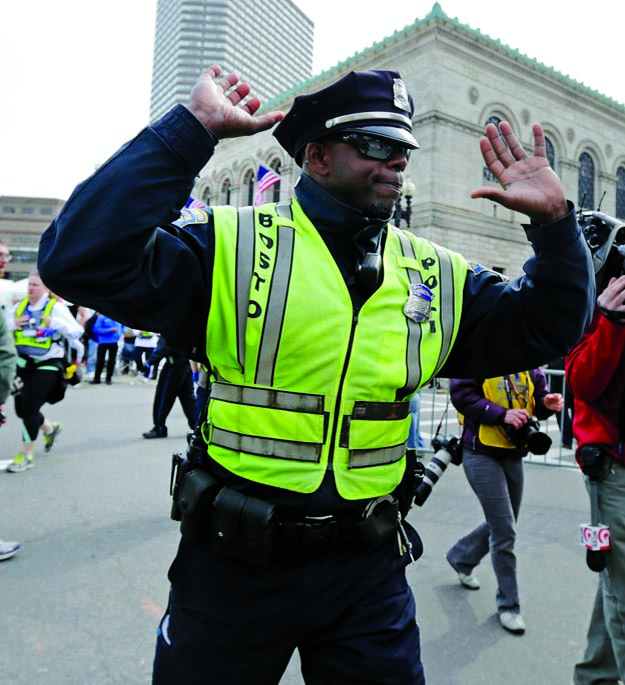Tia Sprengel, Editor-In-Chief
Since 1897, the Boston Athletic Association has hosted the Boston Marathon on Patriot’s Day, the world’s oldest marathon. Roughly 23,000 people were registered to run in the marathon this year, and on average, 500,000 people attend. This year, the marathon ran on Monday, April 15. At 2:50 p.m., about five hours into the race, two bombs near the finish line detonated in quick succession. This event shocked Boston and the east coast, but the reverberations were felt much farther away as professors and students at Illinois Wesleyan struggled to accept the horror of the situation. Three were killed and over 100 more were injured in the attack. The three dead have been identified as eight-year-old Martin Richard, 23-year-old Lu Lingzi and 29-year-old Krystle Campbell.
Immediately after the detonation of the bombs, people were frantically trying to locate their family members to assure that they were safe. Not long after the story had hit the news, many people with family in the Boston area were struggling to make sure that their family was safe as well. Ashton Moss, a first-year at Illinois Wesleyan University, has two cousins that live in Boston and experienced this same panic. Moss said, “As soon as I saw the story on the news, I logged onto Facebook hoping that my cousin had changed her status to let everyone know that she was okay. Luckily she had, and I didn’t have to worry for long.”
Assistant Professor of English Joanne Diaz is from Boston and also has many friends that were in the area. “One of my best friends ran the marathon, and he was two miles away from the finish line when the bombs exploded,” Diaz said. “Also, I used to work at a publishing company a couple of blocks away from the explosion. I still have many friends who still work there, but none were injured.”
According to Mary Nicholas, whose family members were at the marathon, it was immediately evident after the explosions that while many people were running away from the area, there were also a remarkable number of people who ran straight into the chaos to help with the injured. There were even some who ran to the hospital to give blood.
These heroic actions in response to this act of terror have left many people with the conflicting emotions of hope and horror. “My sense is that there are two levels of response: first, I’m amazed by the doctors, nurses, EMTs, policemen and other helpers who saved lives that day,” Diaz said. “On another level, I’ve noticed that Monday’s events, and the scares that have followed, have left most people in the area very frightened and concerned about what will happen next.”
Junior Aaron Smith said, “Good human nature was revealed through those running to give blood, those opening their homes to stranded people, offering Internet access to contact families and those who voiced support across the country.” The immediate bystanders were not the only ones to react quickly.
There were responses in New York City and D.C., which increased security at many important locations, and the FBI was quick to respond to Boston. “My cousin did not get close to the affected area on Monday night,” Moss said. “But about two miles away at her office building, it was a completely different neighborhood. She saw unmarked police and FBI vehicles with lights flashing. She also saw many tourists and office workers on foot. While the subway was open, many people, including my cousin, did not feel safe using it right after the explosions.”
While it is easy to focus on the immediate event, there are many after-effects that the people of Boston and the United States are still struggling to deal with. First-year Jess Omark said, “I was left wondering who was behind it and if there would be another attack.” This was a common fear in the aftermath of these events, and the stepped-up security in NYC, D.C. and Boston did not help to ease this concern.
“I know that my cousin is really struggling to deal with that odd feeling of ‘it could have been me,’” Moss said. “It happened in a busy retail and business area, and it’s also a safe area in a safe city. She said that it’s odd to have military vehicles and national news reporters on the streets where you walk regularly. She has seen military personnel in the subway and on her way home from work. While it is reassuring, it also leaves that unsettling feeling behind.”
Many people are still struggling to wrap their minds around this event. “I can’t stop thinking about my friend who ran the marathon,” Diaz said. “He tried to describe what it felt like to be two miles from the finish line and to have a team of volunteers in yellow jackets just stop the race. How do you stop thousands of people from running as fast as they can toward a bomb? The image has stayed in my head, and I can’t get rid of it.”

